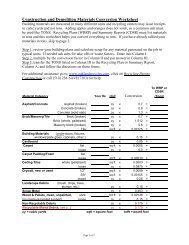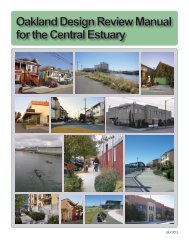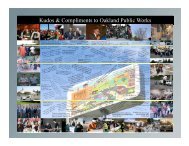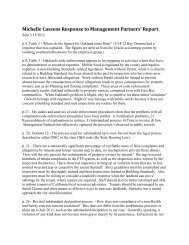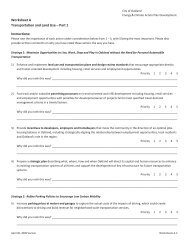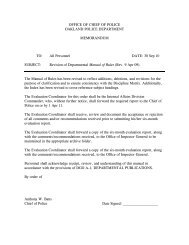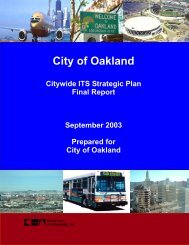Architectural Salvage Assessment, Contributing ... - City of Oakland
Architectural Salvage Assessment, Contributing ... - City of Oakland
Architectural Salvage Assessment, Contributing ... - City of Oakland
Create successful ePaper yourself
Turn your PDF publications into a flip-book with our unique Google optimized e-Paper software.
The report’s author, Woodruff Minor, is an architectural historian and writer with over 25<br />
years experience in a variety <strong>of</strong> contexts, including maritime history, military history, and<br />
on‐site inspection <strong>of</strong> buildings for surveys, studies, nominations, and recordation. His<br />
published works include Pacific Gateway: An Illustrated History <strong>of</strong> the Port <strong>of</strong> <strong>Oakland</strong> (2000),<br />
which deals in part with the history <strong>of</strong> <strong>Oakland</strong> Outer Harbor and the <strong>Oakland</strong> Army Base.<br />
Mr. Minor produced the report as a subconsultant to G. Borchard & Associates (GBA) under<br />
the terms <strong>of</strong> a Master Services Agreement between GBA and the Port <strong>of</strong> <strong>Oakland</strong>. Julie<br />
Woodburn oversaw graphic design. Celia McCarthy, <strong>of</strong> the Port <strong>of</strong> <strong>Oakland</strong> Environmental<br />
Planning and Permitting Department, served as project manager, providing direction and<br />
technical assistance.<br />
1.2 <strong>Oakland</strong> Army Base Historic District<br />
Commissioned in 1941, the <strong>Oakland</strong> Army Base played a vital role over five decades as a<br />
military supply depot in times <strong>of</strong> war and peace. Throughout this period, the historic core <strong>of</strong><br />
the base remained largely intact. In 1990, the California Department <strong>of</strong> Transportation first<br />
identified an <strong>Oakland</strong> Army Base (OARB) Historic District, which was formally determined<br />
by the State Office <strong>of</strong> Historic Preservation to be eligible for listing on the National Register<br />
<strong>of</strong> Historic Places. In 1994, the Army Corps <strong>of</strong> Engineers provided detailed documentation<br />
<strong>of</strong> the district according to the standards <strong>of</strong> the Historic American Engineering Record<br />
(HAER).<br />
In 1995, the Defense Base Realignment and Closure Commission (BRAC) recommended that<br />
the <strong>Oakland</strong> Army Base be closed. The <strong>Oakland</strong> Base Reuse Authority (OBRA) was created<br />
to oversee the conveyance <strong>of</strong> the base from the Army; the property’s transitional use; and its<br />
transfer to the <strong>Oakland</strong> Redevelopment Agency and the Port <strong>of</strong> <strong>Oakland</strong>. Following the<br />
cessation <strong>of</strong> military activity at the base in 1999, OBRA produced Gateway to the East Bay:<br />
Final Reuse Plan for the <strong>Oakland</strong> Army Base (2002). Under the terms <strong>of</strong> the <strong>Oakland</strong> Army Base<br />
Memorandum <strong>of</strong> Agreement (2003), the former base property, including the historic district,<br />
is to be shared by <strong>City</strong> and Port. Transfer <strong>of</strong> title occurred on August 7, 2006.<br />
Situated at the northeast end <strong>of</strong> the former base, the OARB Historic District includes two<br />
subareas separated by Maritime Street, a thoroughfare that bisects the facility. The northeast<br />
(inland) section <strong>of</strong> the district contains 12 contributing structures historically associated with<br />
warehousing and maintenance. The northwest section, bordering the shoreline, retains six<br />
contributors associated with administrative and maritime uses. Together, these 18<br />
contributing buildings—erected for the most part during World War II, although two are<br />
older—form the focus <strong>of</strong> this study. 1 The accompanying map shows the district’s boundaries<br />
1<br />
Five <strong>of</strong> the 23 contributors to the original OARB Historic District are not included in this study. The<br />
Administration Building (Building 1) has been demolished, and the Knight Rail Yard has lost integrity due to new<br />
highway construction associated with the Cypress Structure Project. The base’s three extant wharves, also<br />
contributors to the district, are not covered by the mitigation measures stipulating this study.<br />
3







